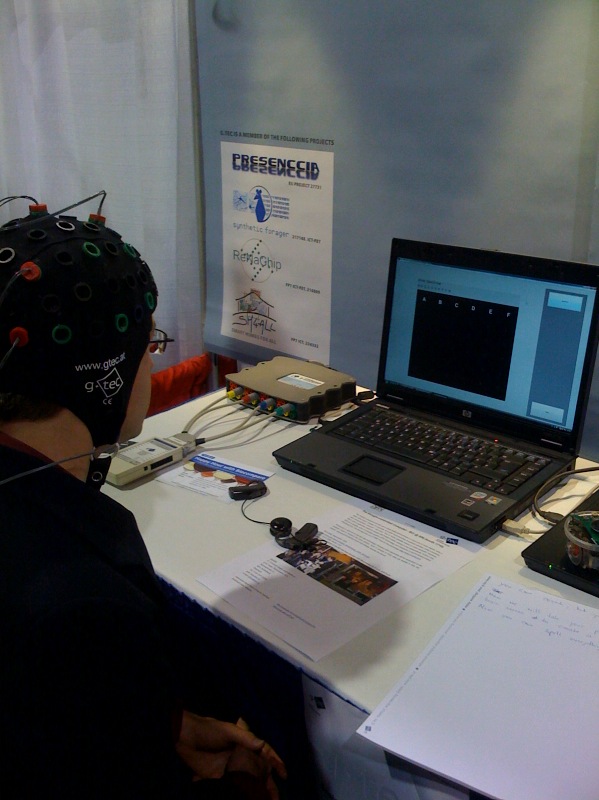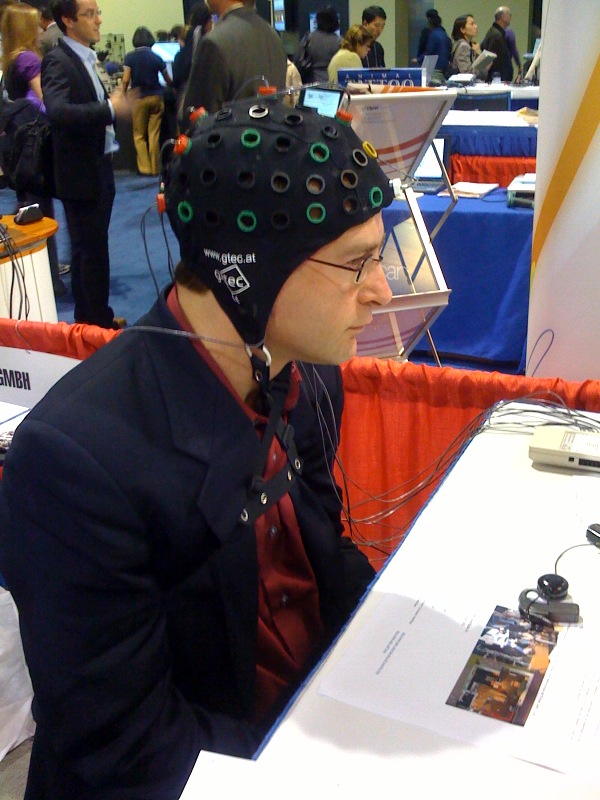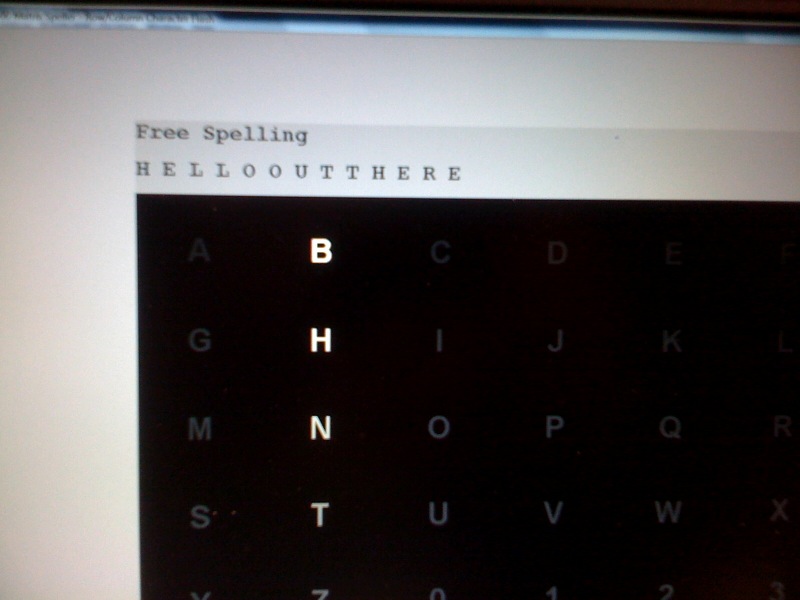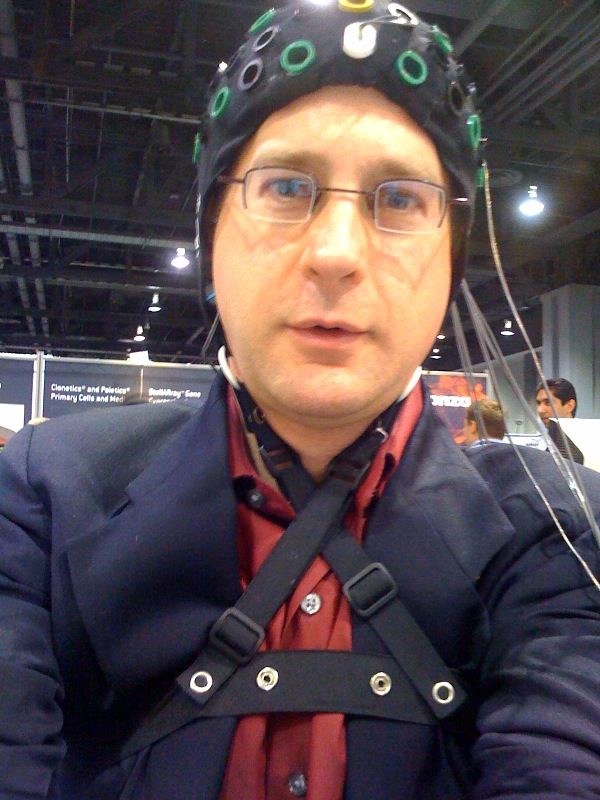In that blessed future when civilization has thrown away its keyboards and people can just think what they want to do, I’ll say to the young ‘uns, “Oh, yes, I first did it that way back in 2008, when you had to wear funny caps and do it one letter at a time.”

|
This was at the Society for Neuroscience’s conference here in Washington DC (for those of you just getting on this blog, I’m spending the year here as a visiting professor.) I’d seen g.tec demonstrate the technology the night before, and I was eager to try it myself.
The cap has sockets for some two dozen electrodes, as you can see. “I’ve got electrodes and chips in my head already,” I said to Stefan Schaffelhofer, one of g.tec’s developers, who looked barely old enough to be out of college. “Is that going to interfere with your electrodes?”
“Oh, no, they’re passive,” Stefan cheerfully assured me. He didn’t see any problem with my wearing my processors under the cap, either.
I confess I was a little nervous when I sat down and he tugged the cap over my head. Electrical fields here, electrical fields there, who knew how they would interact? I was sure that if I called Advanced Bionics for advice, they’d say, eyeing their lawyers, “Heck no. Get out of there.”
I didn’t call Advanced Bionics.
What, I asked Stefan, was I actually supposed to do? How does one type by thinking?
He brought up a screen in which all the letters of the alphabet were arranged, in order. Look at the letter you want to type, Stefan told me. At any given instant, only one letter will appear to be illuminated. When the letter you’re looking at is illuminated, you’ll have a startle reaction that the electrodes will pick up.
“A startle reaction?” I said.
Not actually a startle, Stefan told me. My brain would generate a P300 wave, which is associated with visual recognition. Like the brain saying, “Oh! The letter I was looking at just lit up!”
So all I had to do was look at each letter I wanted until the system finally decided I was looking at it, then move on to the next. The system cycles through the letters so rapidly that “your” letter flashes several times a second.
Stefan started up the system, and letters started flashing. I looked steadily at the H. Every time it lit up, I couldn’t help thinking, “H!” And since it lit up over and over again during the next ten seconds or so, I found myself thinking, “H! H! H! H!”
And then an “H” appeared on the screen.
That was hair-raising. (Not that my hair could go up very far under the cap.)
My goodness, it worked! Quick, find the E and stare at it!

|
After a few seconds, an E silently appeared next to the H.
I moved on to the L. “L! L! L! L!”
Now the screen said, H E L.
Okay, another L…I guess I just keep looking at it, right?
Right.
By now, it was feeling less and less surprising. Something very specific and concrete happened in my mind every time “my” letter lit up. A zing, a pluck, a swish, a beep. A cotillion of neurons did their bob-and-whirl in my parietal lobe, and that created an electrical whoosh that the electrodes could easily pick up. The P300 event-related potential, as real as aggie marbles. Simple! Keep going…

|
“Not bad,” I said to Stefan, with a grin. “It worked. On the first try.”
I’d guess it took me about two minutes to do that. Experienced users, I’d learned the night before, could go about as fast as hunt-and-peck typers.
Was the system reading my mind? Yes and no.
Yes, in the sense that I was typing with mental activity alone.
But I think the deeper and righter answer would have to be “no.” All the system was looking for was that signature of visual recognition, the P300 event-related potential. When it saw it, it simply noted the last letter it had flashed. It had no understanding of the neurological difference beween intending an H versus an E, much less the neural activity of expressing the idea Hello out there.
I heard some scuttlebutt, however, about newer (and also noninvasive) devices that actually do decode neural activity. I’ll be looking into those.
Mindreading or not, the experience was a hoot. When I got back to Gallaudet, I proudly showed the pictures of me wearing the cap to a couple of students in the cafeteria.

|
I still think they think I’m interesting but a little crazy.

Michael,
It seems that (according to http://news-info.wustl.edu/news/page/normal/7800.html) age may have something to do with success in this sort of thing. Bad news for 60s kids like us…
This is so cool! I did my thesis on the P300, but it was not NEARLY as fun as this. My subjects wore that same stylish cap that you are sporting in these pictures;)
Now this is really interesting stuff 🙂